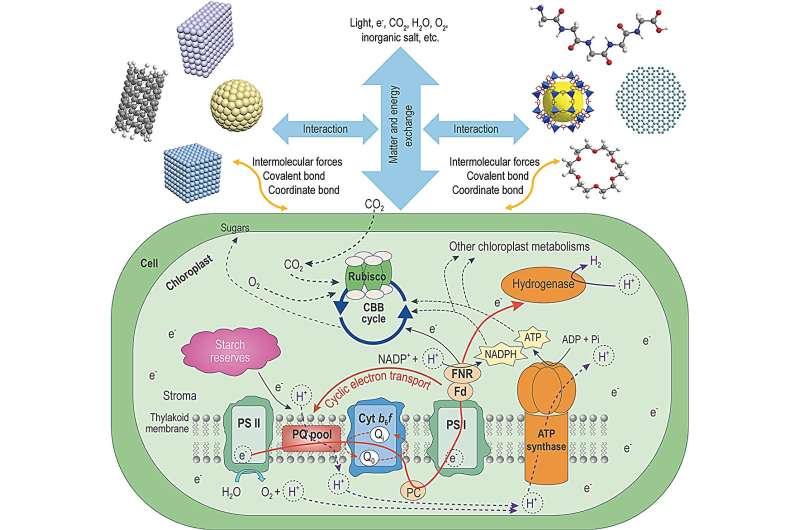In the quest for sustainable solutions to mitigate climate change and achieve carbon neutrality, researchers are turning to nature’s biological systems for inspiration. Among these systems, microalgae emerge as key players in the battle against carbon emissions, with their remarkable ability to fix substantial amounts of carbon dioxide through photosynthesis. However, challenges such as low energy conversion efficiency have hindered the widespread adoption of microalgae-based technologies for carbon sequestration and clean energy production. In response, scientists are exploring innovative approaches that combine microalgae with synthetic materials to create hybrid systems with enhanced functionality and performance. This article explores the transformative potential of microalgae-material hybrids (MMHs) in driving carbon neutrality and revolutionizing various fields, from clean energy to environmental protection and beyond.
The Role of Microalgae in Carbon Neutrality: Microalgae, encompassing diverse species such as cyanobacteria and green algae, play a vital role in the global carbon cycle. Through photosynthesis, microalgae convert carbon dioxide into biomass, serving as natural carbon sinks and contributing to the reduction of atmospheric greenhouse gases. Estimates suggest that microalgae fix over 90 billion tons of carbon dioxide annually, representing a significant portion of the Earth’s net photosynthetic carbon fixation. As the world confronts the challenges of climate change and strives to achieve carbon neutrality, harnessing the potential of microalgae becomes increasingly crucial.
Challenges in Microalgae-Based Technologies: Despite their immense potential, microalgae-based technologies face inherent limitations, particularly in terms of photosynthetic efficiency and scalability. The conversion of light energy into biomass remains relatively low, with only a fraction of incident light being utilized for photosynthesis. Moreover, traditional approaches to enhancing microalgal productivity, such as genetic engineering and metabolic engineering, are often complex, costly, and limited in scope. To unlock the full potential of microalgae for carbon neutrality, innovative strategies are needed to overcome these challenges and optimize energy conversion efficiency.
Introducing Microalgae-Material Hybrids: In recent years, researchers have turned to the concept of microalgae-material hybrids as a promising avenue for advancing carbon neutrality and clean energy technologies. By integrating microalgae with synthetic materials through biomineralization-inspired approaches, scientists aim to create hybrid systems with enhanced functionality and performance. These MMHs leverage the unique properties of both microalgae and materials, offering new opportunities for carbon sequestration, hydrogen production, bioelectrochemical energy conversion, and biomedical applications.
Construction and Mechanisms of Microalgae-Material Interaction: The construction of MMHs involves the formation of biotic-abiotic interfaces through various bonding mechanisms, including intermolecular forces, covalent bonds, and coordinated bonds. Inorganic materials, such as minerals and nanoparticles, interact with microalgal cells primarily through coordination bonds and intermolecular forces, while organic materials form covalent bonds and intermolecular interactions. These interactions influence the exchange of matter and energy between microalgae and the extracellular environment, thereby modulating photosynthetic electron transport and cellular function.
Enhancing Microalgal Functionality: MMHs offer unique opportunities to enhance microalgal functionality through material-endowed improvements. These enhancements are achieved through two primary mechanisms: microalgae-material electron transfer and material-induced cell microenvironment transformation. By facilitating electron transfer pathways and modulating cellular microenvironments, materials integrated into MMHs can optimize photosynthetic performance, metabolic activity, and biomass production. However, challenges such as low energy conversion efficiency and scalability remain barriers to practical application.
Future Directions and Opportunities: Despite current limitations, MMHs hold immense potential for driving progress towards carbon neutrality and sustainable development. Future research efforts should focus on improving energy conversion efficiency, reducing production costs, and scaling up MMH technologies for real-world applications. Furthermore, interdisciplinary collaborations between chemistry, materials science, biology, and environmental engineering are essential to unlock the full potential of MMHs and accelerate the transition towards a carbon-neutral future. As MMHs continue to evolve, they may pave the way for a new discipline known as Material Biology, bridging the gap between synthetic materials and living systems.
In conclusion, the integration of microalgae with synthetic materials represents a promising strategy for promoting carbon neutrality and advancing sustainable technologies. By leveraging the unique capabilities of microalgae and materials, MMHs offer innovative solutions to address the challenges of climate change, clean energy production, and environmental sustainability. As research in this field progresses, MMHs have the potential to revolutionize multiple sectors, from energy to healthcare, and contribute significantly to global efforts to combat climate change and achieve carbon neutrality. With continued innovation and collaboration, MMHs may emerge as key enablers of a greener, more sustainable future for generations to come.
